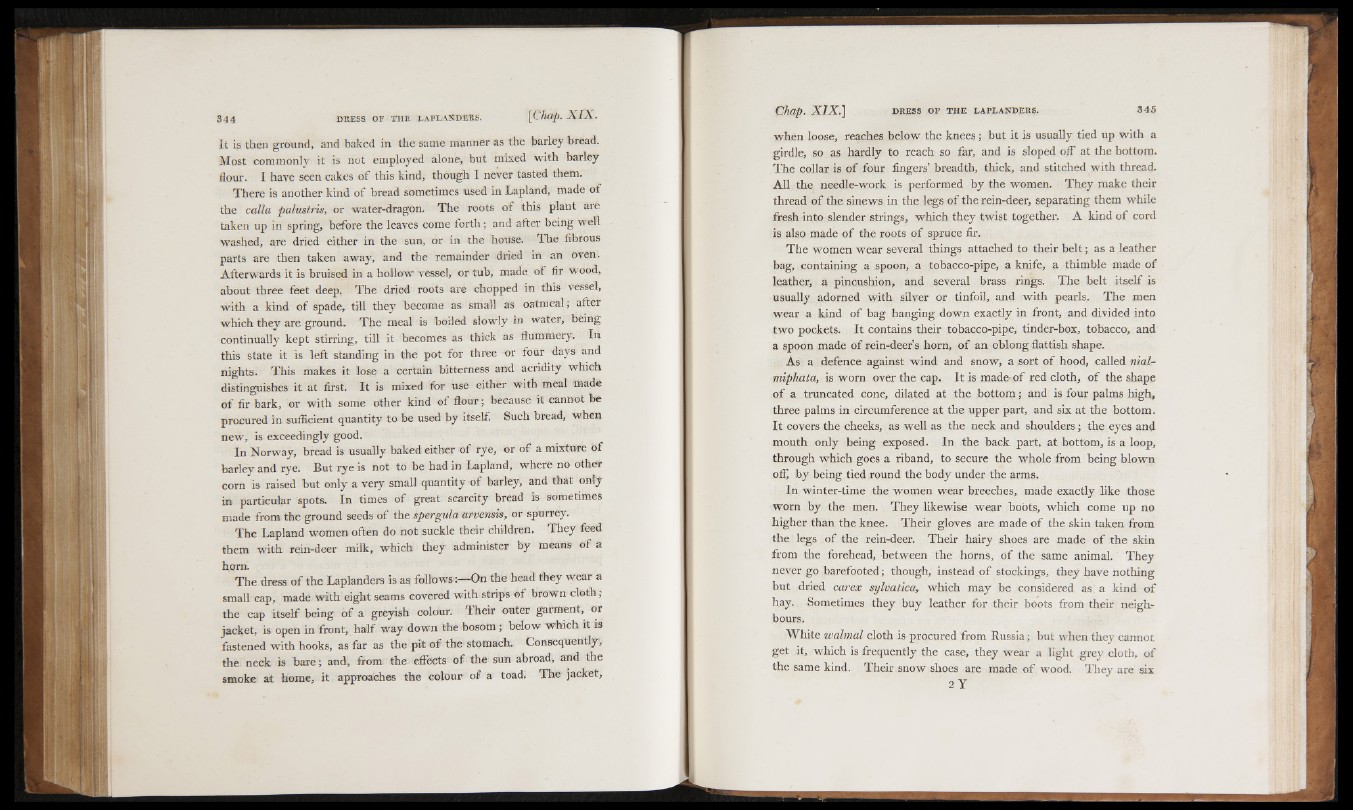
It is then ground, and baked in the same manner as the barley bread.
Most commonly it is not employed alone, hut mixed with barley
flour. I have seen cakes of this kind, though I never tasted them.
There is another kind of bread sometimes used in Lapland, made of
the calla palustris, or water-dragon. The roots of this plant are
taken up in spring, before the leaves come forth; and alter being well
washed, are dried either in the sun, or in the house. The fibrous
parts are then taken away, and the remainder dried in an oven.
Afterwards it is bruised in a hollow vessel, or tub, made o f fir wood,
about three feet deep. The dried roots are chopped in this vessel,
with a kind of spade, till they become as small as oatmeal; after
which they are ground. The meal is boiled slowly in water, being
continually kept stirring, till it becomes as thick as flummery. In
this state it is left standing in the pot for three or four days and
nights. This makes it lose a certain bitterness and acridity which
distinguishes it at first. It is mixed for use either with meal made
o f fir bark, or with some other kind of flour; because if cannot be
procured in sufficient quantity to be used by itself. Such bread, when
new, is exceedingly good.
In Norway, bread is usually baked either o f rye, or of a mixture of
barley and rye. But rye is not to be had in Lapland, where no other
corn is raised hut only a very small quantity-of barley, and that only
in particular spots. In times of great scarcity bread is sometimes
made from the ground seeds of the spergula tivvensis, or spurrtjy.
The Lapland women often do not suckle their children. They feed
them with rein-deer milk, which they administer by means of a
horn.
The dress o f the Laplanders is as folio ws-:^-On the head they wear a
small cap, made with eight seams covered with strips o f brown cloth;
the cap itself being of a greyish colour. Their outer garment, or
jacket, is open in front, half way down the bosom ; below which it is
fastened with hooks, as far as the pit of the stomach. Consequently,
the neck is bare; and, from the effects o f the sun abroad, and the
smoke at home, it approaches the colour of a toad, The jacket,
when loose, reaches below the knees ; but it is usually tied up With a
girdle, so as hardly to reach so far, and is sloped off at the bottom.
The collar is of four fingers’ breadth, thick, and stitched with thread.
All the needle-work is performed by the women. They make their
thread of the sinews in the legs o f the rein-deer, separating them while
fresh into slender strings, which they twist together. A kind o f cord
is also made o f the roots o f spruce fir,
The women wear several things attached to their belt; as a leather
bag, containing a spoon, a tobacco-pipe, a knife, a thimble made o f
leather, a pincushion, and several brass rings. The belt itself is
usually adorned with silver or tinfoil, and with pearls. The men
wear a kind o f bag hanging down exactly in front, and divided into
two pockets. It contains their tobacco-pipe, tinder-box, tobacco, and
a spoon made o f rein-deer’s horn, o f an oblong flattish shape.
As a defence against wind and snow, a sort o f hood, called nial-
miphata, is worn over the cap. It is made- o f red cloth, of the shape
o f a truncated cone, dilated at the bottom; and is four palms high,
three palms in circumference at the upper part, and six at the bottom.
It covers the cheeks, as well as the neck and shoulders; the eyes and
mouth only being exposed. In the back part, at bottom, is a loop,
through which goes a riband, to secure the whole from being blown
off by being tied round the body under the arms.
In winter-time the women wear breeches, made exactly like those
worn by the men. They likewise wear boots, which come up no
higher than the knee. Their gloves are made o f the skin taken from
the legs of the rein-deer. Their hairy shoes are made of the skin
from the forehead, -between the horns, o f the same animal. They
never go barefooted; though, instead o f stockings, they have nothing
but dried carex sylvatica, which may be considered as! a kind of
hay. Sometimes they buy leather for their boots from their neighbours.
White walmal cloth is procured from Russia; but when they cannot
get it, which is frequently the case, they wear a light grey cloth, of
the same kind. Their snow shoes are made o f wood. They are six
2 Y